Home of the Infantry Regiments of Berkshire and Wiltshire
62nd (Wiltshire) Regiment 1756-1881
This section summarises the main events in the development of the Regiment from its foundation up to the time of its amalgamation in 1881. For further information one needs to research The Story of the Wiltshire Regiment (Duke of Edinburgh's). The 62nd and 99th Foot (1756-1959). N C E Kenrick, 1963, held by the Museum.
1756 Raising of 62nd Regiment Of Foot and Service as Marines

A private soldier of the 2nd Battalion of the 4th Regiment of Foot, which later became the 62nd (Wiltshire) Regiment
In October 1756 a second battalion to the 4th Regiment of Foot was formed as part of measures to strengthen the army at the start of the Seven Years' War with France.
In January 1758 four companies of the 2nd/4th Regiment embarked at Plymouth as Marines under Major T Hardy in five ships of Admiral Boscawen's fleet while Battalion Headquarters and the remaining companies stayed at Plymouth. The fleet sailed for Halifax, Nova Scotia, the base for a seaborne attack on French Canada. However, on 21 April while the fleet was part way across the Atlantic came news of a change of name following an official decree that the new second battalions throughout the Army would be numbered as separate regiments. Under this re-organisation the 2nd/4th Regiment became the 62nd Regiment of Foot.
Throughout the Canadian campaign the 62nd continued to serve as Marines, providing landing parties, manning ships' boats, putting artillery pieces ashore and providing local protection for them. During this time the Regiment won its first Battle Honour 'Louisburg' in 1758, but it was not awarded until 152 years later. The reason for this was that since they were employed on board ship the men were on the strength of the navy, not the army, so that at the time the War Office stated they had no record of the Regiment's participation!
1760 Garrison Duties
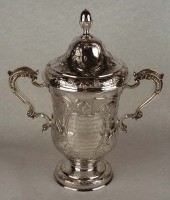
The Carrickfergus Cup
In 1760 9 Officers and 130 men of the 62nd Regiment (mainly recruits) were stationed in Carrickfergus Castle on the Irish coast near Belfast. As part of the plan to break British naval supremacy on the morning of February the 21st 1760 a force of 800 French troops, under Commodore Thurot landed nearby. The Mayor of the town ordered that they must defend the castle at all costs. Although heavily outnumbered, the British force fiercely defended the town, The 62nd Regiment repulsed several attacks, at one point engaging the French at the point of the bayonet. During the fighting a French officer courageously risked his life to save a boy, who was running in the street by putting him safely in a nearby house. The ammunition situation was so grave that the Commanding Officer of the 62nd Regiment ordered that half the powder from each cartridge be fired with the bullet, and the other half the powder be fired with one of the buttons from the men’s coats. In commemoration, the regimental button of the 62nd for years afterwards bore a splash on it as part of its device. The garrison was eventually overrun and effectively held hostage until the French decided to leave. The French were well behaved during their occupation. After leaving Ireland their three ships were captured off the Isle of Man. In 1761 silver cups were present to the officers of the 62nd by the Mayor of Carrickfergus as a token of gratitude for defending the town.(One of these cups can be seen in the Regimental Museum)
1763 West Indies
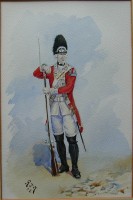
A grenadier of the 62nd Regiment of Foot circa 1768
Following the end of the Seven Years' War in 1763 the 62nd left Ireland for Dominica in the West Indies. Postings to tropical climates always took a heavy toll in terms of deaths from disease, especially local strains of fever to which Europeans had no immunity. In the West Indies the easy availability of strong drink in the form of the rum that was produced there added to the problems. By the time the 62nd were inspected on their return to Ireland in 1769 its effective strength was only 75 rank and file.
1775 American War of Independence and Period to 1790
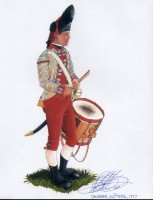
A Drummer of the 62nd Regiment of Foot in 1777
The Regiment was still in Ireland when fighting broke out near Boston between the Colonists and British troops and an American force set out to conquer Canada in 1775. The 62nd sailed for Quebec the following year. The Regiment acted as Light Infantry and were involved in the advance from Canada into the rebel New England colonies under General Burgoyne. They won great praise for their steadfastness and fortitude in a number of actions. At the battle of Freeman's Farm in the Saratoga campaign of 1777 the losses were so heavy that at the end only five officers and 60 men of the 62nd were fit for duty. of reinforcements and supplies eventually caused General Burgoyne to surrender and the remaining members of the 62nd were taken prisoner. By 1780 most of the officers had been exchanged and were back home but few of the men ever saw England again.
In 1781 the Regiment was formerly linked to the County of Wiltshire. The Regiment re-formed over the next two years during which it received new Colours before returning to Ireland in 1784. After six years there it was once again sent to the West Indies where half the Regiment took part in operations against the French in 1794 on the Island of San Domingo. They stormed L’Acul facilitating the reduction of Port au Prince. They remained on this island for three years engaged in intermittent fighting, including a Negro insurrection. In 1795 the Regiment were engaged against the rebellious Maroons (or Hog Hunters) on the Island of Jamaica. This was hard campaigning in close country and jungle which went on for nearly a year. It was finally ended at Pond River when a force under Colonel Hull of the 62nd forced a capitulation.
1803 The Peninsular War

A Sergeant of the 62nd (Wiltshire) Regiment of Foot - circa 1813
A second battalion of the 62nd was formed in 1799. Both battalions were ordered to Holland, but the British forces there returned home before this could be put into effect. The second battalion was disbanded in 1802.
In 1803, Napoleon threatened invasion with his army encamped at Boulogne, as a result of which recruits flocked to enlist and the 2nd/62nd was re-formed at Devizes in 1804. After serving in the Channel Islands the Battalion joined Wellington’s army in the Peninsula in 1813 and was involved in many of the battles which are now household names. In this campaign it earned the Battle Honours of 'Peninsula' and 'Nive' though neither were awarded until some years later. Following Napoleon's abdication in 1814 the 2nd Battalion went back to Ireland. It rejoined Wellington's army the following year, after Napoleon's escape from Elba, but arrived too late to take part in the Battle of Waterloo.
The 1st/62nd left England in 1806 as part of an expedition to Egypt were they joined a force under the command of General Frazer against the Turks. This force was required to retreat losing a 1000 men. The British agreed to evacuate Egypt on the liberation of his men being held by the Turks. After this they went to the Mediterranean and were based in Sicily for several years where they took part in actions against the French at Scylla Castle, The Bay of Naples, Palinuro, and gunboat service off the coast of Italy, and later Genoa, before leaving for North America in 1814. The 2nd/62nd was disbanded in 1817 when 400 men of the Battalion joined the 1st/62nd who were at that time in Nova Scotia. The Regiment remained in Canada until 1823, and then spent seven years in Ireland. Leaving for India in 1830 it was posted to various parts of the country, suffering the usual losses due to diseases like cholera and dysentery. In September 1842 the Colours and regimental records were lost when a hurricane swamped the boats on the River Ganges on which the Regiment was travelling. Both were recovered the following year, but most records were illegible and the Colours unserviceable. New Colours were presented in November 1844.
1845 Battle of Ferozeshah
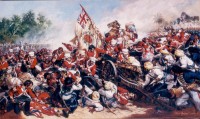
Battle of Ferozeshah in 1845 in India
In 1845 the 62nd was stationed in India and was engaged in the first Sikh War. At the battle of Ferozeshah, 21/22 December 1845, approximately 35,000 of the enemy with more than 100 guns and a strongly entrenched position were attacked and routed by a British force of under 18,000 with 63 guns. The battle was not commenced until late in the afternoon, and just as the British succeeded, after sustaining great losses, in reaching the enemy’s position, night came down and put an end to the fighting for the day. The 62nd led the main attack and suffered horrific casualties on the first day, losing 18 out of 23 officers and 281 out of 580 other ranks killed or wounded. When the battle resumed the next morning most of the Companies were commanded by Sergeants. The gallantry of the Regiment was witnessed by Sir Hugh Gough, the General in Command, and he personally complimented the survivors on their determined attack and for their steady and devoted gallantry under a storm of fire.
The 62nd were engaged in a second battle in this war on 10 February 1846 at Sobraon, as part of the 3rd Division. The Regiment's casualties were relatively light, 2 officers and 45 rank and file, and many of the 62nd's officers and men were praised by the Commanding Officer for gallantry. The service rendered by the Sergeants at Ferozeshah was commemorated by a special regimental tradition – see the Regimental Days section of the Duke of Edinburgh's Royal Regiment page for details.
1854 The Crimean War
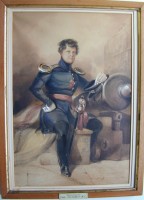
Officer of the 62nd Regiment in the Crimea
Back in England by 1848 the Regiment spent three years there before moving to Ireland, then on to Malta. It was from Malta in November 1854 that it embarked for the Crimea. On their arrival they joined the 2nd Division on Inkerman Heights and were brigaded with a number of units that had been engaged from the start of the campaign, one of these Regiments was the 49th Regiment (later Royal Berkshires). The 62nd spent the worst Russian winter for 100 years in trenches and tents on the heights in front of Sevastopol. In June they took part in their first major action, the assault on the Quarries which were in front of the Great Redan On reaching the Quarries they withstood six Russian counter attacks. The Quarries trench system faced in the wrong direction and as a consequence provided little cover. They ran out of ammunition and continued the fight with swords, bayonets and stones. As a result of the capture of the Quarries ten mortars were installed to support another attack that took place later in the same month. The following September it took a leading part in the attack on the Great Redan, losing half the sergeants and officers and over 100 men. They reached their objective and engaged the Russians in hand to hand fighting. Twenty five of all ranks were, however, mentioned in Despatches for bravery, more than any other Regiment taking part.
British losses in the Crimea were high compared to the size of force involved, with more dying from disease, cold, shortage of food, clothing and medical supplies than from wounds. The 62nd's losses were almost equal to their original strength when they landed and all the officers who had survived Ferozeshah and Sobraon were killed or wounded at Sevastopol.
1856 The Final Years
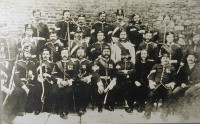
Sergeants’ Mess in Ireland in 1867
After the Crimea the 62nd resumed the normal activities of an infantry regiment in peace time. However, such garrison duties were not without their fair share of hazards, ranging from hostile native forces to illness and disease. It first went to Nova Scotia (Canada), remaining there until 1864. The following two years in England and three in Ireland where they took part in operations against the Fenians. The Regiment returned to India in 1869 where cholera affected them once again. Whilst stationed in India the Regiment provided the best shot in the British Army for the years 1871 and 1872 in the shape of Private George Bryant. The Regiment then went to Aden in 1880.
Under the Cardwell army reforms the 62nd (Wiltshire) Regiment and the 99th (Duke of Edinburgh’s) Regiment became respectively the 1st and 2nd Battalions of the (Duke of Edinburgh’s) Wiltshire Regiment in 1881.